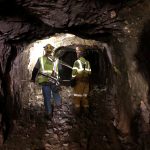From Público, Nov. 24, 2020: Homestake fue la mayor y más profunda mina de oro de de Norteamérica hasta que se cerró en 2002 tras 125 años de funcionamiento. Este remoto lugar de Dakota del Sur se convirtió oficialmente en 2007 en un laboratorio subterráneo de física fundamental, aunque ya mucho antes se habían instalado en sus profundas cavernas algunos experimentos, incluido uno que mereció el premio Nobel. Ahora se anuncia la nueva etapa para convertir la mina en sede del megaproyecto científico más importante de las últimas décadas en Estados Unidos, el Long-Baseline Neutrino Facility, dedicado a estudiar las partículas fundamentales llamadas neutrinos.
South Dakota
From Sanford Underground Research Facility, Nov. 24, 2020: Another series of upgrades to the Ross Shaft is underway at the Sanford Underground Research Facility. Crews are working to outfit the shaft with new cage and skip conveyances and have replaced thousands of feet of hoist cables. The work prepares the Ross Shaft for its role as the main travel way for upcoming excavation and construction of the Long-Baseline Neutrino Facility to support the Deep Underground Neutrino Experiment, the world’s flagship neutrino experiment, which is hosted by Fermilab.
From Black Hills Pioneer, Nov. 17, 2020: Thyssen Mining Company, one of North America’s largest mining companies, has signed a three-year contract to excavate space for the Long Baseline Neutrino Facility at Sanford Lab in South Dakota. The company plans to bring about 110 jobs for miners, operators, mechanics, electricians, engineers, and managers. Thyssen Mining is currently preparing office space in Lead, as well as getting personnel lined up, contracting with local vendors, and preparing equipment for the project.
From Rapid City Journal, Aug. 6, 2020: Crews have begun installing a rock conveyor over U.S. Highway 85 in Lead, South Dakota, for the Long-Baseline Neutrino Facility. The conveyor will bring 800,000 tons of rock from the 4850 level of Sanford Underground Research Facility and deposit them into an open pit mining area that was excavated by the Homestake Gold Mine in the 1980s, making way for the international Deep Underground Neutrino Experiment, hosted by Fermilab.
From Black Hills Pioneer, July 22, 2020: Since late 2019, work has been underway on the Long-Baseline Neutrino Facility conveyor system at the Sanford Underground Research Facility in South Dakota. The system will carry more than 800,000 tons of rock excavated from the site of the international, Fermilab-hosted Deep Underground Neutrino Experiment 4,850-feet below the surface. A major milestone for the project was met on July 20 as the 120-foot section of the truss, which will house the conveyor, was erected above the highway.
Construction workers have carried out the first underground blasting for the Long-Baseline Neutrino Facility, which will provide the space, infrastructure and particle beam for the international Deep Underground Neutrino Experiment. This prep work paves the way for removing more than 800,000 tons of rock to make space for the gigantic DUNE detector a mile underground.
From News at South Dakota State, Feb. 25, 2020: Two South Dakota State University professors are part of an international team of scientists and engineers working to uncover details about how the universe was formed. Stephen Gent and Greg Michna are using SDSU’s high-performance computing cluster to predict how argon circulates within the particle detectors to be constructed one mile beneath the earth’s surface. The detectors are for Fermilab’s Long-Baseline Neutrino Facility/Deep Underground Neutrino Experiment, which will be installed in the Sanford Underground Research Facility in Lead, South Dakota.
From Black Hills Pioneer, Feb. 19, 2020: Data from the Deep Underground Neutrino Experiment could help physicists explain the origin of matter, witness a never-before-seen particle decay and better understand how black holes form in space. To prepare for this groundbreaking science, a major construction project is under way to ready the Sanford Underground Research Facility for its role as the far site of Fermilab’s Long-Baseline Neutrino Facility.
From Black Hills Pioneer, Dec. 13, 2019: Scientists at Fermilab and the Sanford Underground Research Facility in South Dakota are eager to begin collecting data from the Long-Baseline Neutrino Facility and the international Deep Underground Neutrino Experiment, which is hosted by Fermilab. But before the world’s largest neutrino experiment can begin producing results, more than 800,000 tons of rock will need to be removed from the 4,850-foot level of a former mine to make room for the detectors.
From Rapid City Journal, Nov. 28, 2019: The Ross and Yates Shafts were built in the 1930s and served as powerhouses for Homestake Mining Company for years. When asked what is most remarkable about these shafts, the experts unanimously agree — the engineering and craftsmanship that allow these shafts to be used to this day by Sanford Underground Research Facility.

